|
Home Theater Primer
Surround Sound Basics and Generalities:
Surround sound is a type of audio format/system that allows sounds to originate from all areas of the viewing position. As you already know, in movies, as in real life, when there's action going on, there are sounds coming from all directions. Even if all of the action is directly in front of you, there are other sounds that are reflected off of surfaces to your side and behind you. When watching movies, especially action packed movies, there are even more sounds which actually originate from behind the camera's position. To accurately convey the cinematic experience, the film makers use multiple channels to more accurately reproduce those sounds and therefore make you feel like you are actually in the middle of the action. To make the experience as realistic as possible, surround sound systems use 3 or more speakers located in different positions in the listening rooms.
Mono sound:
Most TVs have a single small speaker for audio reproduction. All of the sound has to come from this speaker which leads to a less than realistic reproduction of the audio soundtrack content.
Stereo sound:
A stereo signal leads to a more realistic soundstage. The stereo signal is composed of 2 independent (left and right) signals. The left and right signals of the stereo signal are generally similar but not exactly the same. The two channels are used to give the audio a sense of depth. If your listening position is in the center of the 2 speakers and one instrument or voice is only produced in the left channel, it will seem to originate from the left side of the listening area. If a particular sound is only slightly louder in one of the channels, that sound will seem to originate off center slightly toward the channel in which the sound is louder. If the content of both channels is exactly the same, the voice, musical instrument and everything else will appear to originate from directly between the speakers even though there is no speaker in the center position. When using this 2 speaker type of system to produce a center image, it is sometimes called a phantom center channel. This type of system works erelatively well in producing the center 'image' as long as you're seated directly in the center of the speakers (from left to right). In the following diagram, you can see that there are only 2 speakers. If the drum is played in both channels equally loudly, it will appear to come from the center (between the speakers) even though there is no center channel. Since the horn is only in the left channel, it will appear to originate from the far left. The guitar will seem to originate from the far right.
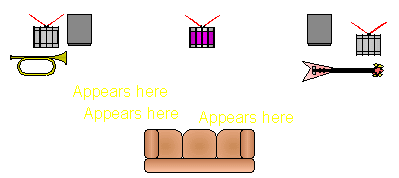
In this image, the guitar is louder in the right channel but is also audible, albeit at a lower level, in the left channel. This will cause it to appear to come from right of center but not from the far right. The drum still appears to originate from the center of the speakers and the horn still appears to originate from the far left.
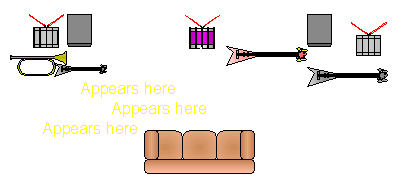
2 Channel Sound:
All of the above works fine as long as you're seated in the middle of the couch. To take it to the extreme, if you were seated directly in front of the left speaker, the proper 'imaging' would not be possible. This may not be really important for audio but when watching a movie, it may be a little distracting and definitely wouldn't give you the best viewing experience possible. Since it's necessary (in a 2 speaker system) for a component (guitar, drum...) of the audio signal to be contained in BOTH channels to appear to come from the center, sitting anywhere other than the center of the room will produce a skewed image. In other words, the instruments that are equally loud in both speakers and should sound like they originate from the center of the room, will actually seem to originate to one side of the room (closer to your listening position).
Simple 3 Channel Front Imaging:
Since everyone can not be (comfortably) seated precisely in the center of the room, a dedicated center channel speaker will provide a more solid center channel image. This center channel would ideally be placed in the center of the TVs display screen. Since it isn't necessary for any of the center channel info to be reproduced by the left and right speakers (because there is now a dedicated center channel), they can be used as dedicated left and right channels. Now if you're seated slightly (or more than slightly) off center, there will be a center speaker which will draw your focus to the center speaker and therefore the viewing screen. This means that most of the dialogue will be reproduced in the center channel and unless the actors are off center in the video, there will be little or no dialogue coming from the left and right speakers. Since the center channel is going to be the most used when watching movies, is must be of at least the same quality as the left and right speakers. When choosing a home theater receiver, its center channel amplifier must have the same output power as the left and right channels. This is becoming more common as of late but some receivers are still designed with lower power output for the center channel.
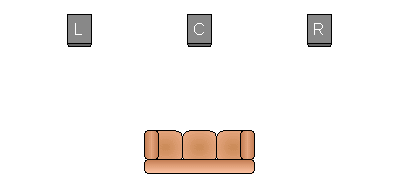
4 Channel Surround Sound (aka: Dolby Pro-Logic):
The previous chapter dealt with the left to right sound stage. To increase the 'depth' of the sound stage, you need to have some of the audio content originate from the sides and/or behind your listening position. That's where the fourth channel comes into play. The sound from the rear surround channel will be produced by either 1 or 2 speakers. If you use a single speaker, the speaker can be directly behind your listening position. If you use 2 speakers (preferred method) for the mono surround signal, you will generally place them slightly behind and a couple of feet above your listening position. They are generally placed on or near the side walls of the room. If they can not be placed on the side walls of the room, they may also placed on the ceiling behind your listening position.
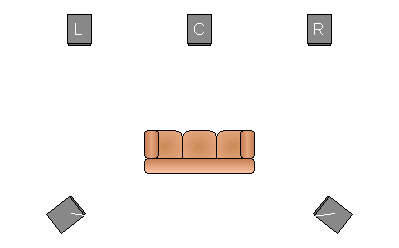
This diagram shows how the guitar's 'image' is projected to the left and slightly behind you when it it reproduced in the front left and to a lesser extent in the surround channels. Since the surround channels aren't independent and are actually a mono signal, the signal is reproduced by the left and right surround speakers, the rear surround effects aren't perfect but are certainly better than a 'front only' speaker system.
5.1 channel digital surround (aka:Dolby Digital, AC-3 and DTS):
This type of surround is capable of reproducing 6 completely independent channels of audio. 5 of the channels are full range (20hz to 20,000hz) and the '.1' channel is a subwoofer (20hz-120hz) channel. In this type of surround, the surround channels are independent of one another. This allows you to have a much more realistic front/rear/left/right sound stage. The audio signal can appear to originate from any one of the 5 full range speakers and sending a signal to a combination of the speakers can make the signal appear to originate from virtually any point on the horizontal plane. This makes it better than any of the previously discussed systems.
In this 5.1 channel system, you can see that the imaging can be more precise. The guitar, which is only reproduced by the left front speaker, seems to originate from the left front of the listening room. The horn, which is only reproduced by the left rear surrond appears to originate from that part of the room. The combination of all of the speakers can make virtually any sound appear to originate from virtually any part of the room. You should also notice the addition of the subwoofer. The subwoofer's placement is not critical and would generally be placed where it produces the best results. Placement of the sub in the corner would likely produce more bass. Placement in the center of the room (near the couch) would result in less extreme low frequency bass.
The specifics of the individual Dolby systems:
Dolby Surround:
Dolby 3 channel surround was one of the first surround formats. It was simply known as Dolby surround. It used a simple matrixed analog signal which was generally decoded by the audio/video reciever. It essentially used the difference between the left and right channels and sent the mono bandwidth limited signal to one or 2 speakers that were placed behind the viewing position.
Dolby Pro-Logic:
Dolby Pro-Logic is a 4 channel surround format which produces 3 full range channels (20hz to 20,000hz) for the left, right and center speakers and 1 bandwidth limited channel that is used to produce frequencies from 100hz to 7,000hz for and rear surround channels.
Dolby Digital or AC-3:
AC-3 is a digital audio coding system developed by Dolby Laboratories. It is better known as Dolby Digital. It provides for the encoding and decoding of 5 full range channels which can reproduce frequencies from 3hz to 20,000hz +/-3dB (20-20,000hz +/-.5dB) and 1 LFE (Low Frequency Effects) channel which covers 3hz to 120hz. The 5 full range channels are for the left, center, right, left surround and right surround. The LFE channel is sent to a subwoofer. More info about Dolby's surround formats can be found at Dolby.com.
Dolby digital is the standard adopted by the DVD manufacturers for use in all territories that employ the NTSC video format (US and Japan). It will also be the standard used in the US for HDTV (high definition TV) broadcasts.
Digital Theater Systems (aka: DTS):
DTS is a competitor of Dolby's AC-3 Format. It is capable of encoding a signal with a dynamic range of 24 bits vs. 20 for Dolby Digital. It is also capable of encoding at a bit rate of 96kb/s vs. a 48kb/s rate for Dolby Digital. This comparison data is just that... for comparison. I am NOT endorsing either format. I believe that you'd be HARD pressed to hear a difference between the 2 coding schemes... all else being equal. More info about DTS can be found at DTStech.com.
Lucasfilm's THX:
THX is not a competing format of Dolby or DTS. It is a certification program which assures (or attempts to assure) that the home video experience will approach or match the actual theater experience. There are 2 different certification programs for home theaters.
THX Ultra:
THX Ultra is the original and most exacting form of home THX certification. It requires that the left, center and right speakers have controlled directivity, especially vertical directivity. This assures the most accurate imaging. The total power response of the system must add up to a flat (equal levels at all frequencies) response. It requires that the system be able to reproduce a 105dB output level across the audio spectrum.
THX Select:
THX Select is a less demanding (and therefore somewhat less expensive) form of THX certification designed for rooms of less than 2000 cubic feet. It allows for left, center and right to have a less controlled directivity. The speakers are also generally smaller and more easily be incorperated into the decor.The total power response must still add up to a flat response and the output must still be able to reproduce levels of 105dB. More about THX can be found at THX.com.
THX Surround Speakers:
THX certification requires that the surround speakers are of dipole configuration. This means that the speakers will, when mounted on a side wall of the room, fire both to the front and rear of the room and direct very little sound toward the listener. The diagram shows how the THX surround speakers fire front to rear along the walls of the room.
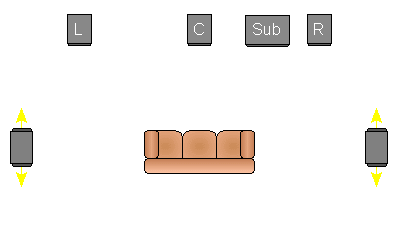
|









